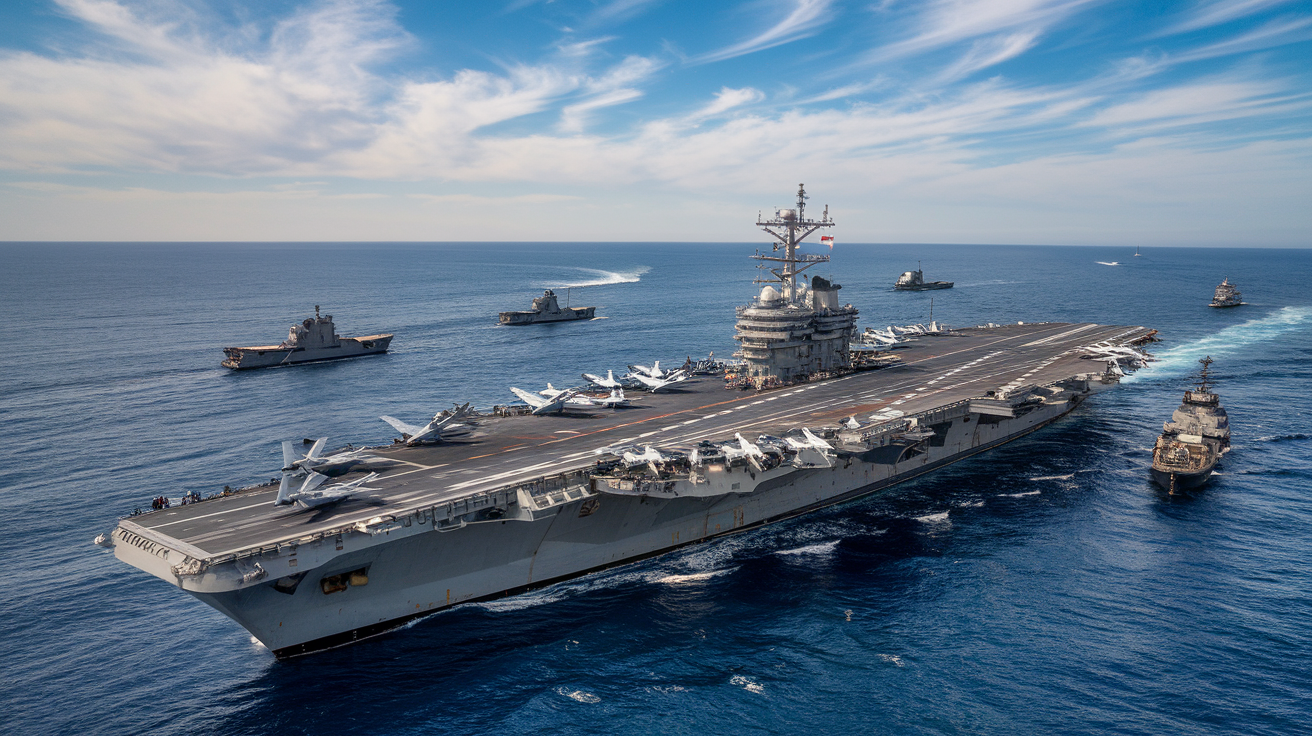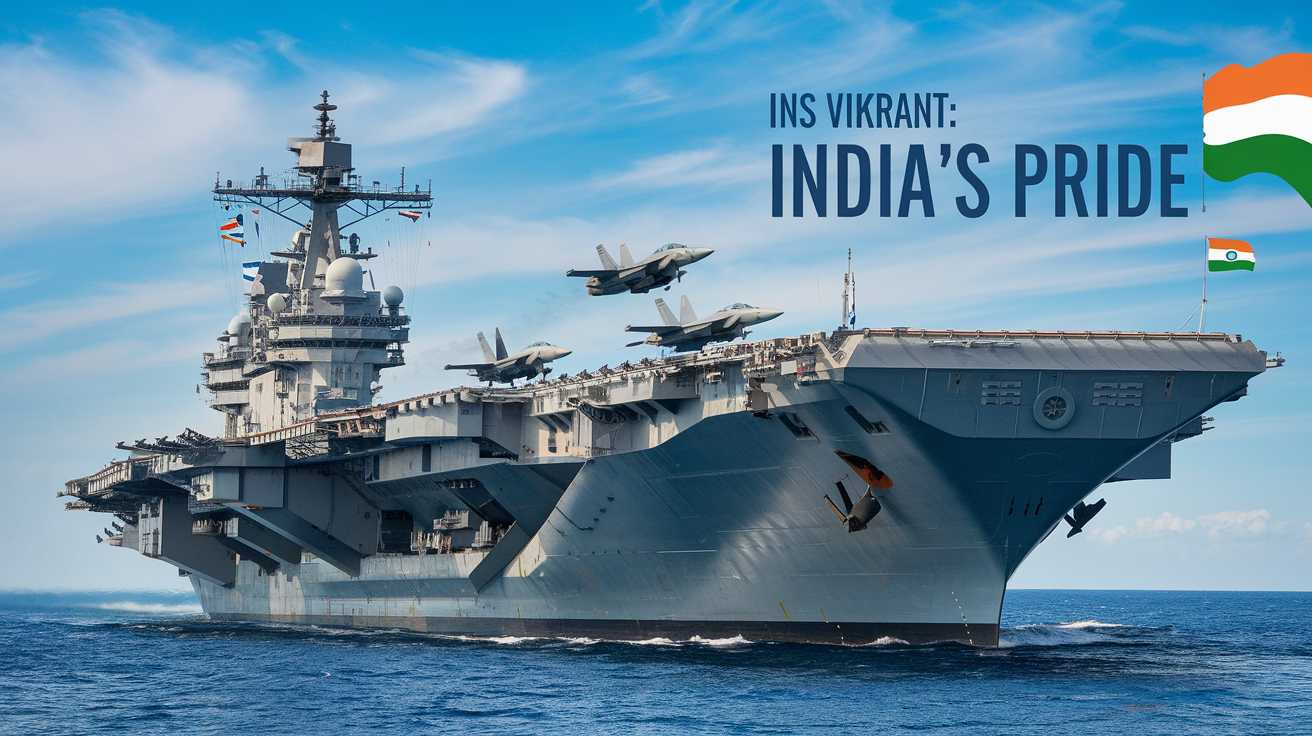India’s naval prowess has taken a giant leap forward with the commissioning of INS Vikrant – the country’s first indigenously built aircraft carrier. 🇮🇳🚢 This marvel of engineering isn’t just a ship; it’s a floating city, a technological wonder, and a symbol of India’s growing self-reliance in defense.
But what makes INS Vikrant truly fascinating? Is it the sheer scale of this 262-meter long behemoth, or the fact that it can generate enough electricity to power 500 households? Perhaps it’s the kitchen that can churn out a staggering 10,000 chapatis daily, or the advanced combat systems that make it a formidable force at sea? 🤔
In this post, we’ll dive deep into 5 captivating facts about INS Vikrant that will leave you in awe. From its impressive specifications and design to its strategic importance, we’ll explore how this technological marvel is reshaping India’s naval history and capabilities. Buckle up for a journey through the decks of this floating city that’s making waves in the Indian Ocean! 🌊
INS Vikrant: A Milestone in India’s Naval History
A. First indigenous aircraft carrier commissioned in 2022
INS Vikrant, India’s first indigenously designed and built aircraft carrier, was commissioned on September 2, 2022. This milestone achievement marks India’s entry into an elite group of nations capable of constructing their own aircraft carriers, alongside the US, UK, Russia, China, and France. The vessel’s construction took over a decade, with the project beginning in 1999 under the Project 71 initiative.
Key facts about INS Vikrant:
- Displacement: 43,000 tonnes
- Length: 262.5 meters
- Cost: Approximately Rs 20,000 crore
- Aircraft capacity: Up to 30 aircraft, including helicopters and MiG-29K fighter jets
- Crew accommodation: Around 1,600 crew members
B. Named after India’s first aircraft carrier from 1961
The new INS Vikrant carries forward the legacy of its predecessor, which was commissioned in 1961. The name “Vikrant” translates to “courageous” in Sanskrit, embodying the spirit of India’s naval aspirations.
Comparison of the two INS Vikrant carriers:
| Feature | Original INS Vikrant (1961) | New INS Vikrant (2022) |
|---|---|---|
| Origin | Acquired from UK | Indigenously built |
| Role | Played crucial role in 1971 Indo-Pakistani War | Enhances India’s Blue Water Navy capabilities |
| Service period | 1961-1997 | 2022-present |
| Displacement | Smaller (British Majestic-class) | 43,000 tonnes |
C. Project 71 initiative: Replacing aging Sea Harrier fleet
The development of INS Vikrant was part of the Project 71 initiative, which aimed to replace the aging Sea Harrier fleet and enhance India’s naval capabilities. This project represents a significant step towards self-reliance in defense manufacturing.
Notable aspects of the project:
- Collaboration between public and private sectors
- Utilization of domestically produced steel for the hull
- Integration of advanced technologies, including a combat management system developed by Tata Advanced Systems
- Implementation of sophisticated radar and missile systems, such as the Barak 8
With the commissioning of INS Vikrant, India now possesses two operational aircraft carriers, the other being INS Vikramaditya. The Indian Navy plans to fully operationalize INS Vikrant by mid-2023, with flight trials scheduled to begin later this year.
Now that we have covered the historical significance and development of INS Vikrant, we’ll explore its impressive specifications and design in the next section, which will provide a deeper understanding of this technological marvel’s capabilities.
Impressive Specifications and Design
Now that we have explored the historical significance of INS Vikrant, let’s delve into its impressive specifications and design, which truly set it apart as a marvel of naval engineering.
A. 262.5 meters long with 45,000 tonnes displacement
INS Vikrant boasts impressive dimensions that underscore its formidable presence at sea. Measuring 262.5 meters in length, this aircraft carrier displaces 45,000 tonnes, making it a substantial naval asset. To put this into perspective:
| Specification | Measurement |
|---|---|
| Length | 262.5 meters |
| Displacement | 45,000 tonnes |
| Width | 60.96 meters |
| Height | 8.53 meters |
These specifications enable INS Vikrant to operate effectively in various maritime environments, providing a robust platform for naval operations.
B. STOBAR design for aircraft operations
The carrier incorporates a Short Take-Off but Arrested Recovery (STOBAR) design, which is crucial for its aircraft operations. This configuration allows for:
- Efficient launch of aircraft using a ski-jump ramp
- Safe recovery of aircraft using arresting gear
- Versatility in accommodating different types of naval aircraft
C. Capacity to carry up to 36 aircraft
INS Vikrant’s impressive carrying capacity further enhances its operational capabilities. The carrier can accommodate up to 36 aircraft, including:
- MiG-29K fighter jets
- HAL Tejas naval variants
- Various rotary-wing aircraft
This diverse air wing enables INS Vikrant to perform a wide range of missions, from air defense to strike operations.
D. Advanced combat management system by Tata Advanced Systems
At the heart of INS Vikrant’s technological prowess lies its advanced combat management system, developed by Tata Advanced Systems. This system integrates:
- Sophisticated radar systems
- Missile defense capabilities
- Electronic warfare suites
- Command and control functions
The combat management system ensures that INS Vikrant can effectively coordinate its air wing and respond swiftly to various threats in complex operational environments.
With these impressive specifications and cutting-edge design features, INS Vikrant stands as a testament to India’s growing naval capabilities. As we move forward, we’ll explore how these technical marvels combine to create what can only be described as a floating city at sea.
A Floating City at Sea

Now that we’ve explored the impressive specifications and design of INS Vikrant, let’s delve into its remarkable features as a floating city at sea.
A. 18 floors, 14 decks, and 2,300 compartments
INS Vikrant is a true marvel of naval engineering, boasting an intricate internal structure that resembles a small city. With 18 floors, 14 decks, and an astounding 2,300 compartments, the carrier provides ample space for various operations and accommodations. This complex layout ensures efficient utilization of space while maintaining the ship’s operational readiness.
B. Accommodates 1,500 personnel including women officers
The carrier’s extensive berthing arrangements can house up to 1,500 personnel, including a diverse crew composition with women officers. This inclusive approach reflects the Indian Navy’s commitment to gender equality and utilization of talent across the board. The ship’s living quarters are designed to provide comfort and functionality for extended deployments at sea.
C. Kitchen capable of producing 10,000 chapatis daily
To sustain its large crew, INS Vikrant features a state-of-the-art kitchen facility. The galley’s impressive capacity is highlighted by its ability to produce 10,000 chapatis (Indian flatbread) daily. This remarkable output ensures that the crew is well-fed and maintains high morale during long missions.
D. 16-bed hospital and 250 fuel tankers on board
INS Vikrant is equipped with essential facilities to support its crew’s health and the ship’s operational needs:
| Facility | Capacity | Purpose |
|---|---|---|
| Hospital | 16 beds | Medical care and emergencies |
| Fuel storage | 250 tankers | Extended range and mission endurance |
The 16-bed hospital complex enhances the carrier’s ability to provide medical care during deployments and supports humanitarian aid missions. The presence of 250 fuel tankers on board significantly extends the ship’s operational range and endurance, allowing it to maintain a strong presence in strategic waters for extended periods.
With these impressive features that make INS Vikrant a true floating city, we can now turn our attention to the technological marvels and self-reliance aspects that further elevate this aircraft carrier’s significance in India’s naval fleet.
Technological Marvel and Self-Reliance
Now that we’ve explored INS Vikrant as a floating city at sea, let’s delve into its technological marvels and how it embodies India’s push for self-reliance.
Domestically produced steel used in construction
INS Vikrant stands as a testament to India’s indigenous manufacturing capabilities. The carrier’s hull is constructed using domestically produced steel, showcasing the nation’s ability to create high-quality materials for critical defense projects. This achievement not only reduces dependency on foreign suppliers but also strengthens India’s defense industrial base.
Cabling length equivalent to distance from Kochi to Delhi
The intricate network of cables running through INS Vikrant is a marvel in itself. To put its complexity into perspective:
| Feature | Measurement |
|---|---|
| Total cabling length | Equivalent to Kochi-Delhi distance |
| Number of compartments | Over 2,300 |
| Number of crew members | Can accommodate 1,600 |
This extensive cabling system supports the carrier’s advanced combat management system, developed by Tata Advanced Systems, and sophisticated radar and missile systems like the Barak 8.
Generates electricity sufficient to power 500 households
INS Vikrant is not just a warship; it’s a powerhouse. The carrier’s impressive power generation capabilities include:
- Producing electricity equivalent to 500 households
- Supporting an air wing of up to 30 aircraft
- Powering advanced operational systems and living quarters
This self-sufficiency in power generation is crucial for extended maritime operations and underscores the carrier’s role as a floating city.
Collaboration between public and private sectors
The construction of INS Vikrant exemplifies successful collaboration between India’s public and private sectors:
- Over 500 Indian firms involved in the project
- 76% of components sourced indigenously
- Cochin Shipyard Limited leading the construction efforts
- DRDO developing specialized materials
This collaborative approach has not only resulted in a state-of-the-art aircraft carrier but has also boosted India’s maritime sector, creating jobs and fostering innovation.
With these technological marvels and self-reliant capabilities in mind, we’ll next explore the strategic importance and capabilities of INS Vikrant in safeguarding India’s maritime interests.






